Backmatter and the Golden Age of Comic Book Letters Columns
In 2015, what have comic creators had to do make letters columns relevant again?
When I was a kid, letters columns weren’t just intermittent curiosities in the back of a comic. They weren’t just something readers skipped at the back of the story either. They were events unto themselves that represented the comic community in monthly fashion.
They were a place readers could ask questions to the people making the comics, find answers, and perhaps most importantly, learn that they’re not alone in their thoughts. These fans – or letter hacks – were legion, and your average letter hack didn’t have the patience to find out when Wolverine would get his Adamantium back. They wanted to know now. And for a time, these were the exclusive place to find answers outside of the comics themselves.
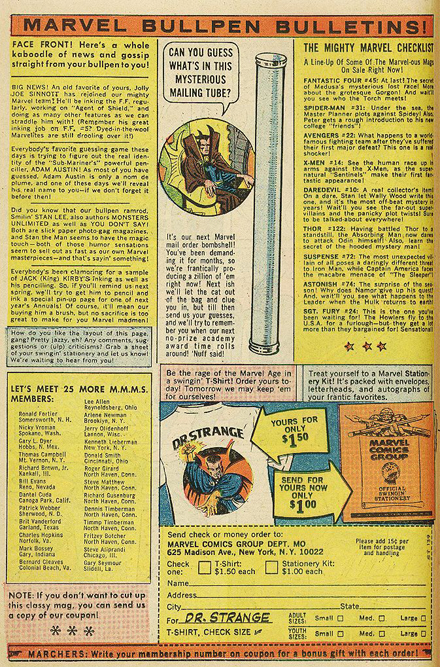
As with many great things, though, letters columns disappeared as other avenues arrived. Marvel’s Bullpen Bulletins – a staple of Marvel comics for 36 years – came to an end in 2001. DC stopped publishing letters columns in 2002. Across the board, these once fundamental elements of the comic form faded. And the reason for that is obvious.
“The internet killed them,” said Augie De Blieck Jr., a veteran of the letter hack community with over 400 published letters who also writes Pipeline at Comic Book Resources. “That’s why they went away. Message boards replaced them. Social networks replaced them.”
In the modern era of comics, the value of letters columns became less apparent. After all, what’s the purpose of writing a letter or an email when you can ask the same creators questions on Facebook, Twitter or Tumblr? For some time, this feature crept to the background in favor of newer, more instantaneous options. Like with anything in the face of great change, letters columns faced two options: evolve or die.
“Letters columns had to take some time off to reinvent themselves, and find a way to be relevant in a day and age when you can ask a creator on Twitter a question at noon on Wednesday about their comic and get an immediate response,” said De Blieck.
That’s just what they did. Creators and publishers found a way to revamp them into something similar but altogether more exciting than they were before. While more rare than in the past, the quality of not just letters columns but comic book backmatter is at a higher point than ever before. Image titles in particular have raised the bar for the richness and depth of the letters column experience. They’ve become not just a superfluous item appended to the end of a comic, but a focal point of comic book fandoms in several cases. They help push titles to higher heights than they may have otherwise.
Seventy-five years after their creation, letters columns aren’t just alive. They’re thriving in what could be described as the Golden Age of comic book letters columns.
The Appeal of the Letters Column
At their core, letters columns are all about the community. While there is a fertile and boisterous community online, letters columns in theory offer more depth, breadth and involvement than the digital space can. That’s a big reason letters columns have become prevalent again, according to Copperhead writer Jay Faerber.
“I think it’s an opportunity to have a more in-depth dialog between readers and the creative team,” Faerber said. “Most creators tend to be on some form of social media these days, but with Twitter in particular, it’s hard to have any sort of lengthy dialog. I think the letters page is a better forum for that sort of thing.”
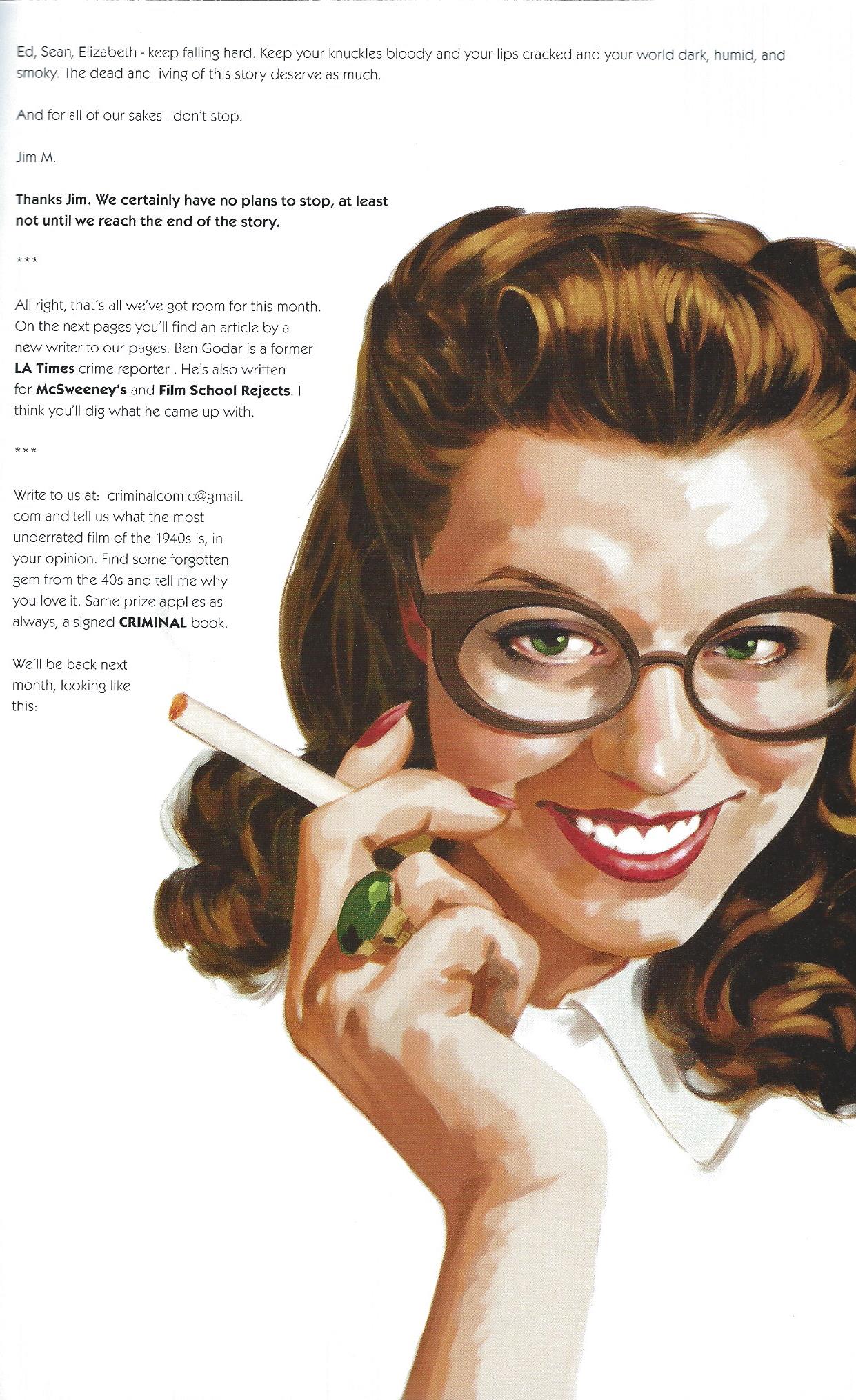
Sebastian Girner, the editor of seven Image titles including Southern Bastards and Deadly Class, agrees with that. As an editor, part of his role includes simplifying and streamlining the letters column process for the teams he works with. That means mapping the backmatter space, selecting letters, putting them in reading order, and editing when needed, all before sending it on to the creative team. He finds that letters columns act as order to the chaos of online discussions about comics.
“Compared to the swirling chaos of online comic message boards, a nice curated letters column can feel like quite a civilized place to engage with other like-minded fans and nerds,” said Girner. “It feels more personal, more direct, and that’s something I think many readers appreciate and want to help foster.”
Many creators today agree with that sentiment. Joe Keatinge, for one, does. He and his Shutter co-creator Leila Del Duca run a letters column in the back of their book every issue. As a fan of the backmatter of books like Madman and Savage Dragon, seeing the letters community develop for his book has been a thrilling experience.
“I thought it was a cool way to give folks who read our stuff a place to have their voice heard beyond the Internet,” he said. “We’ve gotten letters from people all over the world, have had dialog longer than Twitter allows and have a little community going.”
Reed Beebe’s another experienced letter hack – he’s had over 300 letters published since 2010 – and he’s also a fan of the kinship they create. As someone who sends letters to Hellmail in the back of Mignolaverse titles, it gets him excited to see the thoughts of fellow regulars like Matt Strackbein when he reads the books. But it goes beyond just that for him.
“I enjoy learning from the creative team about the characters and creative process,” said Beebe. “For example, one of my first published fan letters was to Scott Allie, and I asked a question about Hellboy’s cigars. Scott revealed that although Hellboy initially smoked cigarettes in the comics, artist Duncan Fregredo started the practice of drawing Hellboy smoking cigars.”
“It was an insight that I would not have gotten were it not for that letter column interaction.”
That direct attention is important to the overall value of letters columns. While much of De Blieck’s desire to write in to comes from his position as a self-professed “opinionated loudmouth,” he appreciates the more personalized letters columns of today. It’s a dialogue, not a monologue.
“I think they’re better today for being more scarce. The people who do them now have a vested interest in them,” said De Blieck. “They’re usually done by the creators or with the creators of the books. They’ll print the good and the bad and answer them directly — or at least, entertainingly. They help to personalize the books, too.”
“In an age of social media, letters columns are now a great way to make the creators more personable and likeable,” he said, before adding, “They can be part of the new comics landscape, where sales are so small that fostering any kind of community — even one as small as six letter writers a month — can be a help.”
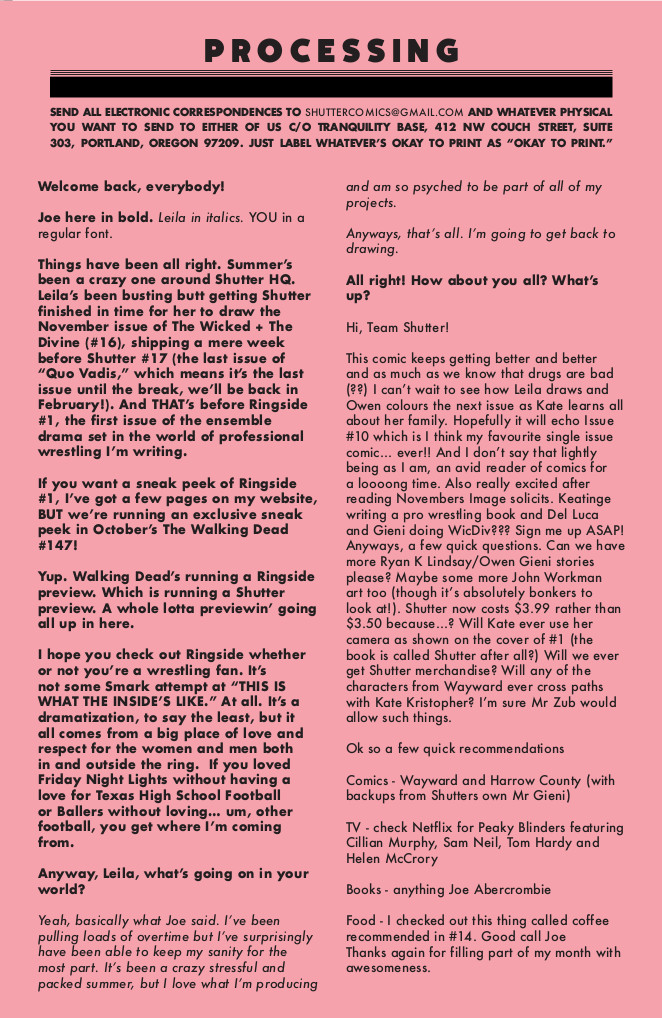
Added value for those who are buying comics on a monthly basis is a huge part of not just the letters columns, but the continued evolution of backmatter in titles. As Keatinge spoke to, they’re a great way to give readers more bang for their buck.
“Comics are so damn expensive these days, but the truth of the matter is the single issue readers pay our rent and make it possible for these things to exist under the economic model we’re working in,” said Keatinge. “It’s really important to me to give them as much for their dollars as possible. The letters column is part of that, for sure, along with the back up comics, pinups, etc.”
Girner agreed with that sentiment, sharing it’s a reward for the Wednesday Warriors who take the trip to the comic shop each week. With creators striving to keep readers engaged as monthly readers, the bonus content letters columns and backmatter can offer goes a long way.
The value of a letters column can be a complex thing, offering different benefits both to creators and to readers. It’s not just straight question and answer anymore. These columns help foster a community and add value to the overall package. But letters columns can also drive a simple emotional connection Faerber knows from experience.
“I think it’s still a kick for people to see their name in print,” he said. “I wrote fan letters way back when and enjoyed when they got printed.”
De Blieck agreed with that, sharing, “I won’t lie — it’s a nice buzz to see your name in print when you crack open new comics in a Wednesday.” As someone who has had two letters published in his life, I can back that idea.
They’re exciting. They help build a community. Sometimes, they can even help keep readers from switching to trades thanks to the extra value they bring to the product. But they’re much more than letters in 2015. While they once were a place for dialogue between creators and their readership, they’ve evolved into something greater in many cases. That’s something that has helped develop and involve fan bases in many exciting new ways.
An Evolution in Print
Backmatter. It’s a phrase you’ve seen tossed around in comic conversations, but you might not know what it means. When someone uses that phrase, it’s in regards to letters columns and more specifically the other material placed at the back of a comic. It’s a big part of the current evolution of the letters column space into something greater than it was before. Letters columns aren’t just a place for questions about characters anymore. They are where readers can tell the creative team how a story resonated with them emotionally. Where creators can share their process or emotional connection to what’s on the page. Sometimes, backmatter is even a place where additional story is delivered in unique ways.
They’ve become well-rounded founts of information that don’t just add to the comic experience, but become an one themselves. It’s been exciting to see creators push them in different directions, finding new ways to express information and connect with readers than before. But how are they accomplishing that? There are several ways. Instead of walking you through those, we will look at some of the best examples of comic backmatter today and what they’re bringing to the table. While mileage may vary as to the perceived quality of those listed, they each offer something special for those looking for more from their comics.

Currently the Master of the Letters Column domain, Sex Criminals’ back matter “Letter Daddies” plays things straight, for the most part. Sex Crimz is all about engaging its fan base – or Brimpers, as they call themselves – on topics that range from being “about the comic” to being “about this growth I have on my junk.” It has tongue-in-cheek sex advice (i.e. “Sex Tip: ‘Dick Pics’ were named for their inventor, Dr. Richard Pics.”), real sex advice, bizarre hypotheticals, and incredible fan interaction. Matt Fraction and Chip Zdarsky have made this section such a spectacular event every issue that I’d keep buying the comic even if it took a significant turn for the worse, and I’d wager I’m not the only one. That’s saying something.
Hell, it’s so good they made a book that expanded on the backmatter called Just the Tips. When have you ever heard of that? Never, that’s when. A comic’s backmatter was so popular it became its own book? That’s a hell of a thing. If I had one complaint (or is it “cumplaint”?) it’s that it puts me in awkward situations with my wife when she asks why I’m giggling like a mad man. Then I have to explain myself. Thanks Matt and Chip. Thanks a lot.
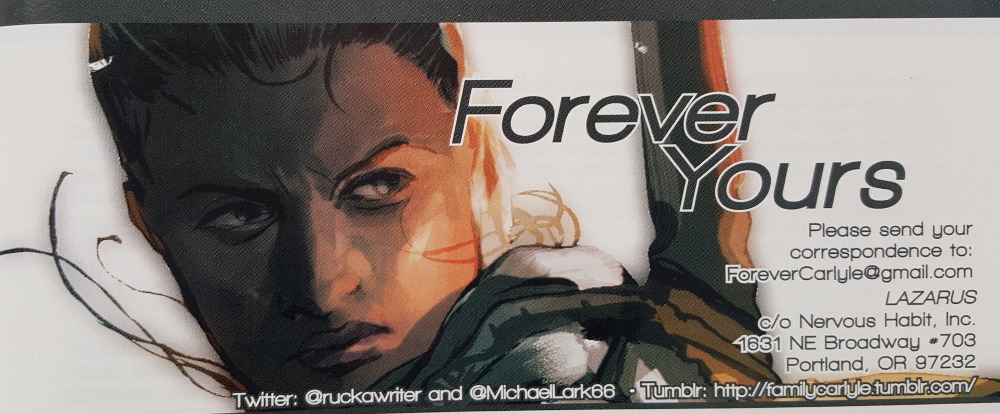
On the other end of the spectrum in terms of seriousness but not in quality is the backmatter in Lazarus, the Image title from Greg Rucka and Michael Lark. On its own its letters column, Forever Yours, is superb. I enjoy the depth Rucka goes into on responses, the concluding remarks he leaves readers with (including interesting science updates!), and Lark fielding questions occasionally in particular. But its greatest value lies is in the information it weaves in around the letters. Lazarus as a book is one that has a stunning amount of depth to its world building, and it continues beyond the pages of the actual comic.
Whether it’s the graphical timelines of the story that preceded the comic, the breakdowns of the families that dominate the book’s new world order, or the advertisements for products from the world, Rucka, Lark, designer Eric Trautmann and the rest go above and beyond in using this space not only for answering reader questions, but enhancing the overall product. You can skip it if you’d like, but it adds so much to the experience. It’s essential reading for Lazarus fans.

Community involvement is a huge part of making these letters columns worthwhile. You don’t want marketing speak dominating your backmatter, but true interaction. Few do that better than “Processing…”, the letters column for Keatinge and Del Duca’s Shutter. They’ve incorporated media recommendations into every column, both from themselves and readers. They ask readers to share what music, movies, TV, comics, books, etc. they’re enjoying, and then add their own into the mix. Seems simple, but it’s something I enjoy and have put to great use. When I told Keatinge that I had found music I dig in the letters column, he grabbed onto that thought to describe why they include it.
“Right there. That. The fact you’ve found some good music tips,” Keatinge said. “Madman in particular introduced me to a lot of stuff (that) has really informed me. When I was a teenager into absolutely shitty music, Mike mentioned the Dandy Warhols and I picked up OK Rule and that in turn turned me onto so much more, like David Bowie. Pretty sure I also discovered comics like Eightball and movies like Eraserhead from Madman’s letters columns. I absolutely love the recommendations people send in. One guy has been recommending bourbons and I am all about it.”
Beyond that, the team also features comics from lesser known creators, including Tiger Lawyer from Ryan Ferrier and various artists, as well as pin-ups from friends of the book. Pair the extra comic, the pin-ups, and the fan interactivity together, and you have something more than just a comic.

For a comic like Brian K. Vaughan and Fiona Staples’ Saga, they could have run pictures of their favorite enchiladas of the month as their letters column and been fine. But To Be Continued, the book’s letters column, is a masterpiece of interactivity. It’s an inventive experience that brings unique wrinkles to the table every issue. Those include BKV’s sidekick/dachshund Hamburger K. Vaughan picking the best letter every month, with that person winning an often hilariously random assortment of prizes. They also do a yearly reader poll in which readers are asked to send in answers to a laundry list of questions Vaughan creates. They have a Saga costume contest, with prizes involved. Oh, and To Be Continued only accepts letters sent by post. No emails. The barrier to entry on To Be Continued is higher than it is for other books, but I’m guessing it still gets the most letters of any title.
Maybe my favorite part of the letters column is how it tears down the walls of comics as collectibles. Vaughan has shared in the past how shocked he is when readers rip the pages of the comic out to answer the yearly poll. Saga readers aren’t buying the book to collect it. They’re buying it to be a part of it, and its letters column shows that off better than anything.

The backmatter of Ed Brubaker and Sean Phillips’ partnership is, for many, the Rolls-Royce of the form. We see it in every passing issue of their current work, The Fade Out. It’s a title built off history, and as with their other works, The Fade Out leverages that with thoughtful essays placed in the back of each issue from varying guest writers (the first issue’s piece by Birth. Movies. Death.’s Devin Faraci about Peg Entwistle, an actress who killed herself by leaping off the Hollywood sign, is superb).
Beebe’s a huge fan of what The Fade Out offers, saying, “The Fade Out has one of my favorite back matter sections; the creative team answers questions from fans, but also has these great essays on Hollywood history that I enjoy reading.” He also cited Gabriel Hardman and Corinna Bechko’s Invisible Republic for the same reasons. These types of essays are great added value for readers who enjoy robust stories of this type, and it’s a superb marriage of readership and content.
Even better? These essays do not appear in trades or the digital version of the issue. They only appear in back of the print comic. It’s great incentive for readers to stick to that format.

While Marvel’s letters columns are rare (or at least rarely inspiring), some are. Letters From Nuts, the letters column for Ryan Q. North and Erica Henderson’s splendid The Unbeatable Squirrel Girl, is a delight. My favorite part is how much they love fan interaction. Photos of readers with squirrels and cosplaying at events are common, but for me, the best part are the kids. They regularly feature letters from parents talking about their kids loving the book, of kids writing in themselves, or of kids reading the book. For a medium that many believe isn’t kid friendly, this book lives in direct opposition to that notion. And they even have pictures to prove it!
The letters column has a lively personality that’s as infectious as the comic that precedes it, with North and Henderson having a lot of fun responding to letters. For a book that doesn’t take itself seriously and breaks the fourth wall like that’s what it is there to do, it’s the perfect bookend to the Squirrel Girl reading experience.
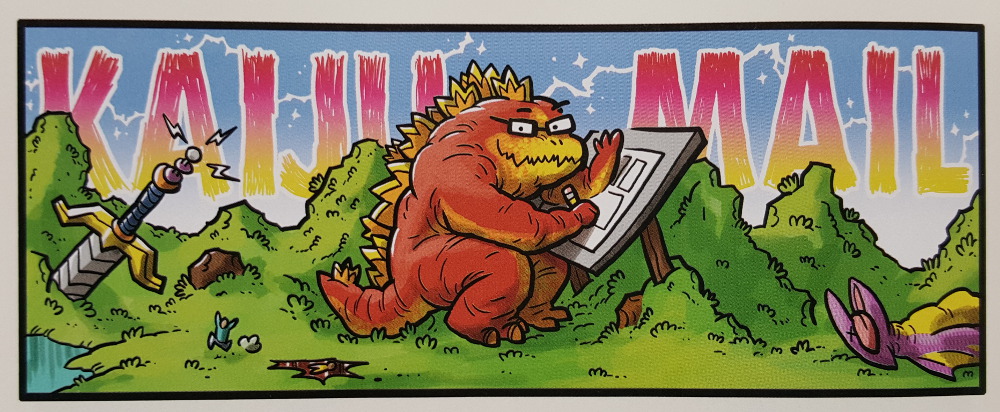
Zander Cannon’s Kaijumax is a book that often surprises me – mostly in how sad it makes me – but its letters column, Kaiju Mail, is predictably fantastic every issue. While Kaijumax excels with the straightforward letters element, where it stands out is the depth it goes to in engaging its readership. It has some of the most unexpected and unique features of any letters column, including my two favorites: Kaiju Rekwests and Kaiju Movie Capsule Reviews.
The identity of the latter is obvious: they’re kaiju movie reviews Cannon writes for varying films throughout history. As a monster movie fan, it’s a blast reading Cannon’s thoughts on some of the classics. The former, however, is a feature that spotlights reader suggested kaiju drawn by Cannon for the letterscol. Recent examples include “Cybertrex” and “Capybaragon,” and yes, they are as amazing as they sound. Kaiju Mail does a phenomenal job of building on fan interaction and developing a rapport between readers and the title, and it does it in ways that blend traditional elements with Cannon specific touches.

The last one I wanted to highlight is an oldie but a goodie: the Mignolaverse letters columns (or Hellmail). Series editor Scott Allie puts those together, and he doesn’t just compile a letters column: he’s a fan of the form. As people who grew up with them, both Allie and Mike Mignola see what letters columns add to the overall experience, with Allie calling them, “an essential part of the experience, something message boards can’t compete with.” That love extends to the readership as Beebe shared.
“The Mignolaverse letter columns managed by Scott Allie are my favorites,” said Beebe. “Scott does a great job of respectfully interacting with fans and sharing great information, and I think those letter columns are an important component in building a strong fan community around all of Mike Mignola’s comics.”
That community interaction continues to grow, as Allie shared a cool wrinkle in an upcoming edition of Hellmail.
“Actually, today I have a couple readers taking over Hellmail for an issue of Abe Sapien. There used to be a great Hellboy message board on CBR Forums, but Jonah shut that stuff down a few years ago for excellent reasons. An incredible community had built up there, and still exists to a degree,” Allie said. “The two women I have running the lettercol have written in dozens of times, contributed to the message boards, I believe, and now they’re contributing in another way.”
That’s above and beyond, and another reason the book has one of the great letters columns.
Building a Better Community
It’s true. Today, we have more ways than ever to talk about comics with each other and those who create them. Much of the value of letters columns was absorbed by the online community. You can go onto infinite amounts of comic sites every week to read reviews of what you just read. Forums and social media are there for discussions about the events within the book. Many writers and artists are on social media, and even more have easily accessible email addresses for direct correspondence. In this era, is there really a need for letters columns?
No. Probably not. And that’s why they’ve become something better than they were before – because they needed to.
As De Blieck noted, comic creators needed time (and a healthy dose of nostalgia) to decide to bring letters columns back. Today’s creators grew up on letters columns, like you and me. They also saw them fade away. That gave them the critical distance necessary to decide if letters columns resonated with them anymore. For many, that time away helped find a way to bring them back as not just marketing hype, but as something of value to the overall comic book experience. We’re all better off for it.
Even today, letters columns aren’t for everyone. But in books like Sex Criminals, Saga and The Walking Dead (the father of the modern letters column, in some ways), they add value to the overall reading experience. They make us laugh. Sometimes, they make readers cry. They bring us as a readership together, and that value can never be underestimated.
“(It’s) a small investment of time and effort for a big payoff that can really help solidify the identity of a book and its creators,” said Girner.
For creators, the value is obvious. Letters columns tether readers even more to their creations. They can make the readership feel like an unofficial part of the team. And for readers like Beebe, it gives them a chance to connect with the comics he loves.
“I enjoy writing fan letters because I feel that I am contributing content to a comic; my opinions will become a permanent part of the comic,” said Beebe. “I feel honored when a creator or editor chooses to publish and respond to my letter; it creates a connection to a creative team and to a comic that you can’t get from social media.”
So yes, the internet’s free-flowing conversation did replace much of what letters columns once were. For all intents and purposes, there isn’t an obvious need for what they bring to the table. But what creator wouldn’t want to create that connection Beebe is speaking of? And what reader wouldn’t want to feel that? In today’s era of cyberbullying and online harassment, letters columns have become a haven for fans of all types to share their passion for the comics they love. They’ve even expanded beyond that, giving those invested in the title bonus material as a reward for their faithful readership. In 2015, letters columns are anything but inessential. In many ways, they represent everything we love about comics in an era of frequent divide.
Thanks to Scott Allie, Reed Beebe, Augie De Blieck Jr., Jay Faerber, Sebastian Girner and Joe Keatinge for the contributions to this piece.
